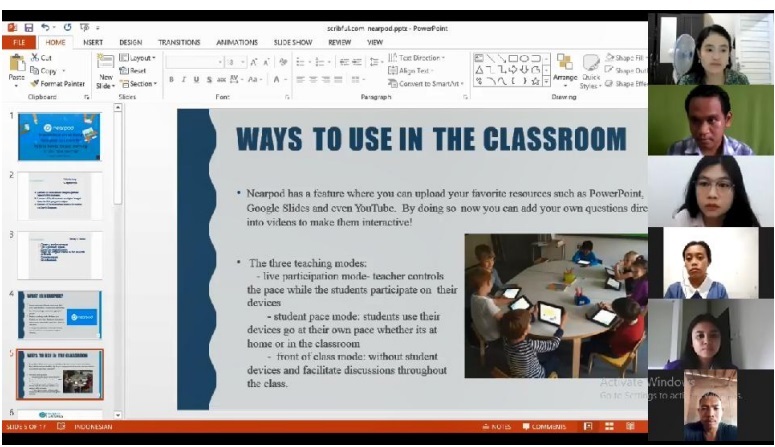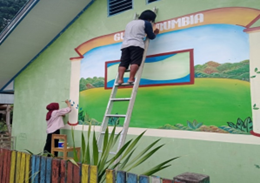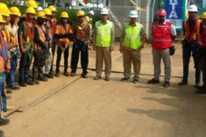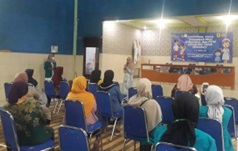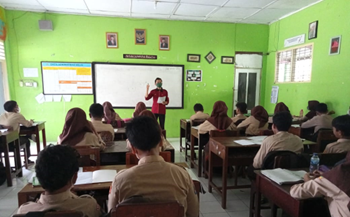EDUKASI “HOMEMADE HEALTHY FOOD” PADA IBU TENTANG PEMANFAATAN BISKUIT DARI TEPUNG BIJI NANGKA UNTUK MENGATASI MASALAH GIZI PADA ANAK USIA DINI DI PAUD TERPADU AISYIYAH BUSTANUL ATHFAL-27
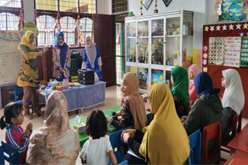
Downloads
Early childhood nutritional problems have an impact on growth and development delays that are difficult to cure. Therefore children who have nutritional problems have limited abilities to learn and work and behave compared to normal children and have quite a large potential if they grow into adults who are less healthy. The problem of undernutrition or stunting in Indonesia is still a concern for the government. The prevalence of malnutrition and undernutrition, as much as 3.9% with malnutrition and 13.8% with undernutrition. The prevalence is related to height, there are 11.5% very short and 19.3% short toddlers. The incidence of undernutrition or stunting at the Amplas Health Center in Medan city in August 2022 was 10 people occurring in early childhood. In general, the feeding schedule for early childhood is 3 main meals and 2 side dishes, by providing side dishes in the form of snacks/snacks or healthy snacks that can help meet their nutritional needs. These children's snacks can use local food ingredients because of the affordability of prices and the availability of these ingredients in the surrounding environment. Aisyiyah Integrated PAUD Medan Amplas District is one of the early childhood education centers that carries out learning in an educative and interesting way. In addition, the implementation of monitoring from health workers includes body weight, height and head circumference periodically once a month, but this examination is not balanced with the mother's knowledge about the causes of undernutrition, and complementary food given to children to improve the child's nutritional status to be good To help Aisyiyah Early Childhood Education in increasing knowledge of overcoming the problem of malnutrition in early childhood, it is necessary to socialize education about the use of food from jackfruit seed flour to make biscuits. Utilization Jackfruit seed is a non-economic material and as a waste product for jackfruit consumers. Based on the description above, the problems that can be formulated include how to increase the knowledge of mothers who have early childhood at PAUD Aisyiyah in Medan Amplas about preventing nutritional problems and using jackfruit seeds to make biscuits as a snack. The target of this community service activity is mothers who have early childhood. The purpose of this activity is for mothers with young children to know how to prevent nutritional problems, know the content of jackfruit seeds to prevent nutritional problems and can use jackfruit seed biscuits to prevent nutritional problems in children. The method of implementing the community service which was carried out on January 6, 2023 included delivering community service materials, direct practice (learning by doing) making biscuits from jackfruit seed flour, and providing assistance.
Angkasa, D., Sitoayu, L., & Dewanti, L. P. (2020). Buku studi kasus program gizi masyarakat.
Asta, H. (2021). Kadar karbohidrat: fortifikasi fe pada biskuit limbah biji nangka sebagai cemilan fungsional bagi penderita stunting. Agrofood, 3(2), 28–35.
Ayuningtyas, A., Simbolon, D., & Rizal, A. (2018). Asupan zat gizi makro dan mikro terhadap kejadian stunting pada balita. Jurnal Kesehatan, 9(3), 445–450.
La Ode Alifariki, S. K. (2020). Gizi Anak dan Stunting. Penerbit LeutikaPrio.
Lia Fentia, S. S. T. (2020). FAKTOR RISIKO GIZI KURANG PADA ANAK USIA 1-5 TAHUN DARI KELUARGA MISKIN. Penerbit NEM.
Listiarini, U. D., Sari, I. D., & Sutiah, S. (2022). KAJIAN POLA ASUH DAN PEMBERIAN ASI EKSKLUSIF DENGAN STATUS GIZI BALITA. Jurnal Gentle Birth, 5(2), 59–62.
Monika, A., Simbolon, D., & Wahyu, T. (2021). Hubungan Cakupan Imunisasi Dasar dan ASI Eksklusif dengan Status Gizi Balita di Indonesia (Analisis Data Riskesdas 2018). Journal of Nutrition College, 10(4), 335–342.
Nugroho, M. R., Sasongko, R. N., & Kristiawan, M. (2021). Faktor-faktor yang Mempengaruhi Kejadian Stunting pada Anak Usia Dini di Indonesia. Jurnal Obsesi: Jurnal Pendidikan Anak Usia Dini, 5(2), 2269–2276.
Organization, W. H. (2014). Global nutrition targets 2025: Stunting policy brief. World Health Organization.
Rahman, S. (2018). Teknologi Pengolahan Tepung dan Pati Biji-Bijian Berbasis Tanaman Kayu. Deepublish.
Sanjaya, I. T. I., & Ayu, M. S. (2022). FAKTOR-FAKTOR RISIKO YANG MEMPENGARUHI KEJADIAN STUNTING DI PUSKESMAS AMPLAS KELURAHAN HARJOSARI 1 KECAMATAN AMPLAS KOTA MEDAN TAHUN 2020. Ibnu Sina: Jurnal Kedokteran Dan Kesehatan-Fakultas Kedokteran Universitas Islam Sumatera Utara, 21(2), 152–160.
Sari, K. T. P. (2012). Pemanfaatan Tepung Biji Nangka (Artocarpus heterophyllus lamk) sebagai Substitusi dalam Pembuatan Kudapan Bebahan Dasar Tepung untuk PMT Balita. Skripsi, Jurusan Ilmu Kesehatan Masyarakat, Fakultas Ilmu Keolahragaan, Universitas Negeri Semarang, Semarang.
Silaban, T. D. S., Rahmadhani, S. P., & Sugiman, T. (2022). Perbedaan Tingkat Kecukupan Vitamin A, Zat Besi, dan Zink pada Balita Stunting dan Non Stunting di Kabupaten Banyuasin. Jurnal Kesehatan Andalas, 11(1), 39–44.
Unicef. (2014). The state of the world’s children 2014 in numbers: every child counts. New York: UNICEF, 3.
Copyright (c) 2023 Bd. Indah Dewi Sari, Bd. Mayang Wulan, Bd. Utary Dwi Listiarini

This work is licensed under a Creative Commons Attribution-NonCommercial-ShareAlike 4.0 International License.







